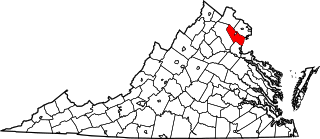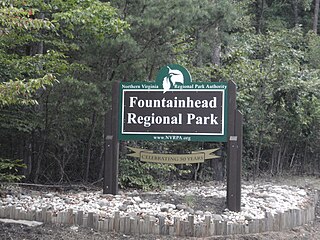
Prince William County lies beside the Potomac River in the U.S. state of Virginia. At the 2020 census, the population was 482,204, making it Virginia's second most populous county. The county seat is the independent city of Manassas.

Clifton is an incorporated town located in southwestern Fairfax County, Virginia, United States, with a population of 243 at the time of the 2020 census.

Woodbridge is a census-designated place (CDP) in Prince William County, Virginia, United States, located 20 miles (32 km) south of Washington, D.C. Bounded by the Occoquan and Potomac rivers, Woodbridge had 44,668 residents at the 2020 census.
Bull Run or Bullrun may refer to:
The Potomac Heritage Trail, also known as the Potomac Heritage National Scenic Trail or the PHT, is a designated National Scenic Trail corridor spanning parts of the mid-Atlantic region of the United States that will connect various trails and historic sites in Virginia, Maryland, Pennsylvania, and the District of Columbia. The trail network includes 710 miles (1,140 km) of existing and planned sections, tracing the natural, historical, and cultural features of the Potomac River corridor, the upper Ohio River watershed in Pennsylvania and western Maryland, and a portion of the Rappahannock River watershed in Virginia. The trail is managed by the National Park Service and is one of three National Trails that are official NPS units.
NOVA Parks is an inter-jurisdictional organization that owns and operates more than 10,000 acres of woodlands, streams, parks, trails, nature reserves, countryside and historic sites in Northern Virginia in the United States. The Authority was organized in 1959. NOVA Parks presently operates 34 regional parks.

Bull Run is a 31.8-mile-long (51.2 km) tributary of the Occoquan River that originates from a spring in the Bull Run Mountains in Loudoun County, Virginia, and flows south to the Occoquan River. Bull Run serves as the boundary between Loudoun County and Prince William County, and between Fairfax County and Prince William County.

Fountainhead Regional Park is an approximately 2,000 acre regional park, bordering a tributary of the Potomac River, in Fairfax County, northern Virginia.
The Millard H. Robbins, Jr. Water Reclamation Plant, which is operated by the Upper Occoquan Service Authority (UOSA), is located in Centreville, Virginia and it was formerly known as the Upper Occoquan Sewage Authority. UOSA serves the western portions of Fairfax and Prince William Counties, and the Cities of Manassas and Manassas Park. The sewage treatment plant includes primary-secondary treatment and the following advanced wastewater treatment processes: chemical clarification, two-stage recarbonation with intermediate settling, multimedia filtration, granular activated carbon adsorption, chlorination for disinfection and dechlorination. The plant’s rated capacity is 54 million US gallons (200,000 m3) per day (mgd).

Pohick Creek is a 14.0-mile-long (22.5 km) tributary stream of the Potomac River in Fairfax County in the U.S. state of Virginia. It takes its name from the Pohick Native American tribe once prevalent in the area.

Difficult Run is a 15.9-mile-long (25.6 km) tributary stream of the Potomac River in Northern Virginia in the United States. The area has had many historical uses dating back to the early 1800s. Today, the area is used recreationally by visitors interested in the watershed's variety of options including hiking, biking, fishing, boating, climbing, and bird watching. The wildlife at Difficult Run is vast as 163 different species can be seen depending on the season. There are 41 different soil types found on the trail and alongside the stream. The stream is part of the greater 57.7- square-mile Drainage basin, or watershed, located in the north-central portion of Fairfax County and drains directly to the Potomac River.

Broad Run is a tributary of the Potomac River in Loudoun County, Virginia. The creek, located between Goose Creek and Sugarland Run, principally drains portions of eastern Loudoun County, as well as a small portion of western Fairfax County.

State Route 612 in Fairfax and Prince William Counties, Virginia is a secondary state highway. The two counties are separated by water, so SR 612 contains a bridge that is one of only eight crossings between the counties. Because of this, SR 612 is heavily traveled during rush hour.

Occoquan Reservoir is a 2,100-acre (850 ha) reservoir in northeast Virginia, southwest of Washington, D.C., straddling part of the boundary between Fairfax County and Prince William County, west of Alexandria. It is formed by the Occoquan Dam on the Occoquan River.

The Virginia Scholastic Rowing Association (VASRA) is a 501(c)(3) that promotes and supports scholastic rowing in Virginia and sponsors and conducts competitive rowing regattas for high schools in Virginia.

County Center is a census-designated place in Prince William County, Virginia, United States. The population as of the 2010 Census was 3,270. In 2021, the United States Census Bureau estimated it to be 4,045. It is notable for including the county's McCoart Government Center off Prince William Parkway, along with adjoining Pfitzner Stadium, former home field of the Potomac Nationals, now the Fredericksburg Nationals.

The Bull Run-Occoquan Trail (BROT) is a hiking trail in the U.S. state of Virginia. Designated in 2006 as a National Recreation Trail, the Bull Run-Occoquan Trail invites hikers and horseback riders to discover more than 4,000 acres of scenic woodlands.
The Cameron Run Watershed (CRW) is a highly urbanized, 44 square-mile watershed located in Northern Virginia. "The region is completely urbanized with nearly 95 percent of the watershed developed with mixed residential and commercial use". Seventy-five percent of the watershed lies in Fairfax County, and the rest lies in Arlington County and the cities of Falls Church and Alexandria. In addition to several streams (called “runs”), there are two lakes—Lake Barcroft (137 acres) and Fairview Lake (15 acres)—and four ponds. There are eight sub-watersheds within the CRW. The western part of the CRW lies within the Piedmont; the southeastern part in the Coastal Plain.

Holmes Run is a stream in the Cameron Run Watershed in Northern Virginia. It runs through Fairfax County and the City of Alexandria. It is a first-order tributary of the Potomac River.

















